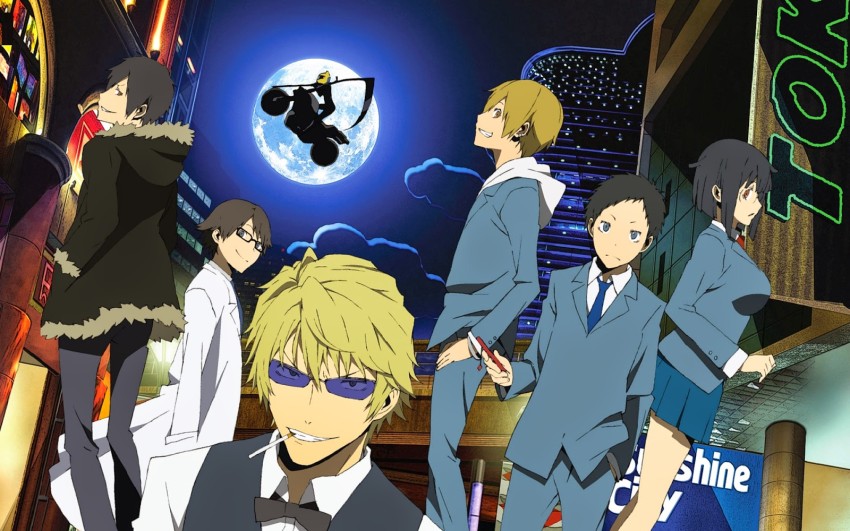Durarara Returns
March 25, 2016 · 0 comments
By Andrew Osmond.
 One of the central sequences in Durarara!!x2 Sho has several characters – including a headless faerie biker, her mad scientist boyfriend, a super-strong bartender, a shy girl with lethal occult powers, and a boy who’s the secret founder of an anarchist army – enjoying a hot pot party. “Hot pot” is also a fair description of this series, the continuation of the excellent Durarara!!, made in 2010 and already available from Anime Limited.
One of the central sequences in Durarara!!x2 Sho has several characters – including a headless faerie biker, her mad scientist boyfriend, a super-strong bartender, a shy girl with lethal occult powers, and a boy who’s the secret founder of an anarchist army – enjoying a hot pot party. “Hot pot” is also a fair description of this series, the continuation of the excellent Durarara!!, made in 2010 and already available from Anime Limited.
If you’ve not seen the original Durarara!!, then click here for our write-up, because Durarara!!x2 Sho is not the place to start. If you haven’t seen the first Durarara!! for a while, then you might rewatch it before heading to the sequel, which very much assumes you’re up to speed, remember who everyone is, what their dark secrets are, and where we left them all. Then it doubles the cast (well, it feels like it!), throwing a horde of newcomers in our faces: a serial killer, scary pretty twin girls, Russian and Japanese mobsters, a womanising dandy and a sneaky new student. Even the titles strain to fit everyone in.
The show has loads of different strands, such as one involving the aforementioned serial killer, who we soon learn is a troubled young woman who – not unusually in Durarara’s world – harbours dark powers. The later episodes resume the gang plotlines from the first series, as elements within the Dollars anarchist movement founded by diffident student Mikado – and oh, the irony of that name! – start picking gang feuds for lulz.
Intentionally or not, the Dollars have parallels with the Anonymous online movement whose profile has only risen in the years between the first Durarara!! and the second. The original series had a rousing moment when the day was saved by a crowd of “anonymous” strangers who suddenly united at the sound at a ringtone, V for Vendetta for the mobile generation. The sequel is more sceptical of the Dollars’ ideals, wondering if the bad will chase out the good and asking if a nice-guy kid like Mikado has a place anymore.
Or is Mikado a nice guy? Another motif in the sequel, perhaps even more than in the original, is to have characters feel their hollowness, their flimsily constructed identities. The show’s Loki-like villain suggests to Mikado that being nice is fine, but can nice guys grow as people? Durarara!! is full of characters intersecting; long scenes consist of nothing but characters messaging each other on colourful bulletin boards. But the show asks if these are friends coming together, or lonely strangers, falling apart?
 Durarara!!x2 Sho has been criticised for its overcooked plotting, which sometimes feels so dense it leaves you gasping for air (though the hot pot party is a breather). It was broadcast as a weekly serial, but feels designed for ‘block’ viewing – not necessarily a one-sit marathon, which would be exhausting, but for viewing over a short time so you’re not always asking, “Where was I?” It’s a whirligig portrait of a whirligig world. Keep up with the rush of plot and you’ll get a sense of how the headless biker feels zooming up the side of a building.
Durarara!!x2 Sho has been criticised for its overcooked plotting, which sometimes feels so dense it leaves you gasping for air (though the hot pot party is a breather). It was broadcast as a weekly serial, but feels designed for ‘block’ viewing – not necessarily a one-sit marathon, which would be exhausting, but for viewing over a short time so you’re not always asking, “Where was I?” It’s a whirligig portrait of a whirligig world. Keep up with the rush of plot and you’ll get a sense of how the headless biker feels zooming up the side of a building.
The show’s fond of tricky timeshifts – even the first episode goes into a flashback, then a flashback in the flashback. Episodes loop round timelines, piecing themselves together on the fly – cutting from fights into conversations, or into how-did-I-get-here-again extended flashbacks, or conversely having the characters literally fast-forward to the present. Add jazzy moments of randomness, like a hitman demanding to know why men have nipples; no more Royale with cheese!
The show’s still grounded in the brightness of Ikebukuro, and much of the fun is still in seeing a real Tokyo location as the meeting place of crazy characters bouncing off each other. Durarara!! makes Ikebukuro a fantasy space like the city of Ankh-Morpork in Terry Pratchett’s Discworld, or “the little (Gaul) village we know so well” in Asterix. It’s not all fun; one flashback has a crazed Russian general burning bodies, and the show has a thing about giving nasty traumas to females. But instead of the women being rescued by boys like Mikado, instead their saviours are the bright lights, the looped mayhem and the friendly madness of Ikebukuro itself.
Andrew Osmond is the author of 100 Animated Feature Films. The second Durarara series is released in the UK by Anime Ltd.
Leave a Reply